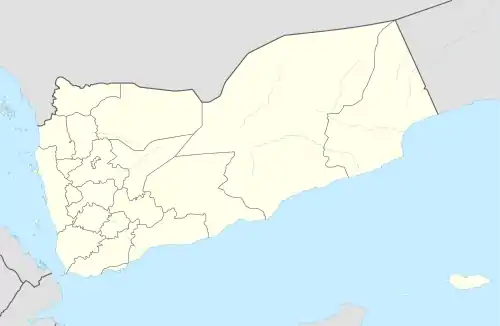Khanfar
خنفر | |
|---|---|
Village | |
 Khanfar Location in Yemen | |
| Coordinates: 13°12′43″N 45°18′20″E / 13.21194°N 45.30556°E | |
| Country | |
| Governorate | Abyan |
| District | Khanfar |
| Time zone | UTC+3 (Yemen Standard Time) |
Khanfar (Arabic: خنفر) is a village that is a southern suburb of Jaʿār in the Abyan Governorate of south-western Yemen. It is said to be inhabited by Yafa peoples.[1]
History
The business minded British had an influence in the 19th and 20th century in development with the Khanfar Development Board being financed by British loans. The British overlooked the construction of irrigation works and in 1947 the Khanfar scheme was reorganized as the Abyan Development Board, financed by credits of £170,000.[2] Khanfar was noted for its ceramics, particularly its Rasulid glazed mustard wares.[3][4]
In the mid 1980s, the Soviets built an ammunitions factory in Khanfar, for the manufacture of light weapons and Kalashnikov rifles.[5] After the fall of the Soviet Union it continued to operate as a centre of weapons production, On March 28, 2011, an explosion occurred, killing some 150 people and injuring many more,[6][7] a day after around 30 armed al-Qaeda militants raided the "7th of October" ammunition plant, stealing cases of ammunition and leaving gunpowder exposed at the site;[8] militants took over another nearby munitions factory in Khanfar. According to Al Jazeera, the initial fire was reportedly triggered by a local resident dropping a lit cigarette while inside the looted factory,[9][10] as some were checking the site for weapons,[11] which soon led to an explosion. It was loud enough to be heard roughly 15 km (9.3 mi) from the factory, and left many charred bodies at the scene. Compiling the death toll was made more difficult as many bodies were found completely burnt through.[9] Some of the injured people were taken to Jaʿār for treatment, while others received treatment at a hospital in Aden.
References
- ↑ Markham, Sir Clements Robert (1874). The Geographical magazine. Trübner & Co. Retrieved 29 March 2011.
- ↑ Stookey, Robert W. (1982). South Yemen, a Marxist republic in Arabia. Westview Press. p. 23. Retrieved 29 March 2011.
- ↑ Potts, Daniel T. (1988). Araby the blest: studies in Arabian archaeology. Museum Tusculanum Press. p. 200. ISBN 978-87-7289-051-7. Retrieved 29 March 2011.
- ↑ Donald S. Whitcomb; Janet H. Johnson (1982). Quseir al-Qadim 1980: preliminary report. Undena Publications. ISBN 978-0-89003-112-4. Retrieved 29 March 2011.
- ↑ Katz, James Everett (1986). The Implications of Third World military industrialization: sowing the serpents' teeth. Lexington Books. p. 82. ISBN 978-0-669-09754-2. Retrieved 29 March 2011.
- ↑ "Yemen: Blast Kills 150 In Arms Factory Raid". Sky News HD. March 29, 2011. Retrieved 29 March 2011.
- ↑ Almasmari, Hakim (March 28, 2011). "Blast at Yemen Munitions Plant Kills at Least 124". The Wall Street Journal. Retrieved 29 March 2011.
- ↑ "Abyan Explosion Kills Scores". National Yemen. March 28, 2011. Retrieved 29 March 2011.
- 1 2 Jazeera, Al (28 March 2011). "Scores killed in Yemen arms factory blasts". Al Jazeera. Retrieved 29 March 2011.
- ↑ Lu, Hui (March 28, 2011). "Death toll in Yemen ammunition factory blast rises to 70". Xinhua. Archived from the original on April 3, 2011. Retrieved 29 March 2011.
- ↑ "Yemen: Blast Kills 110 In Arms Factory Raid". Sky News HD. March 28, 2011. Retrieved 29 March 2011.